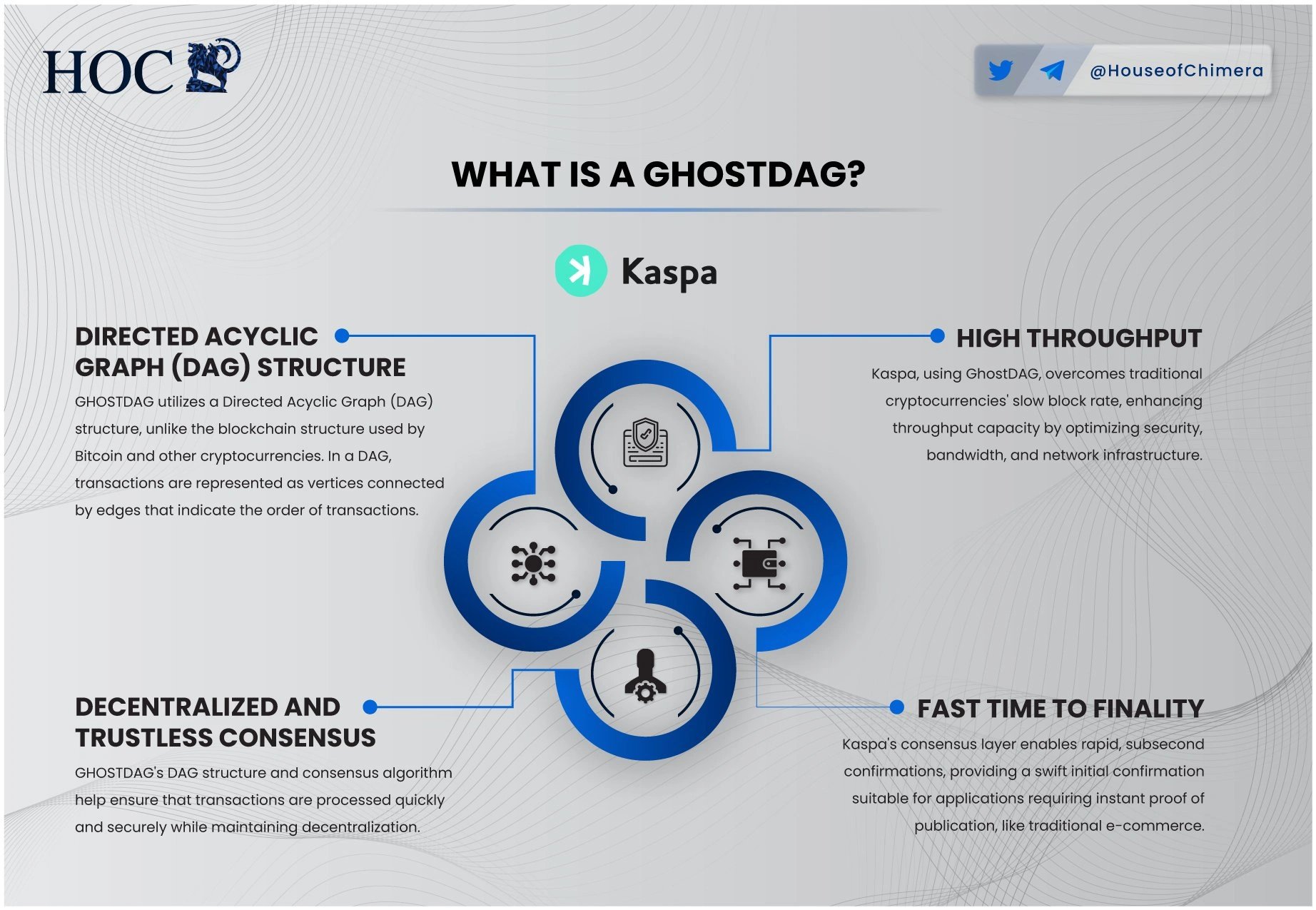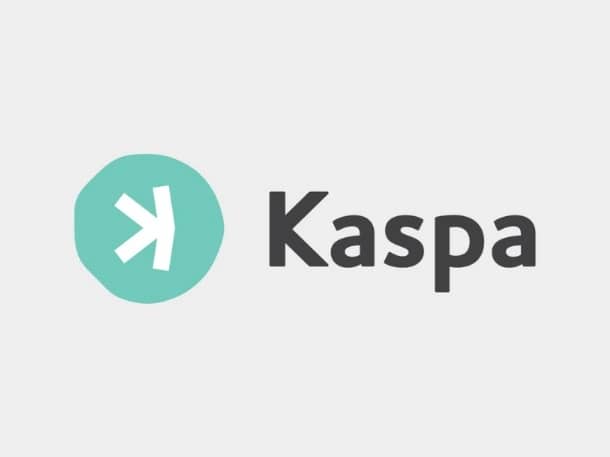KASPA
**카스파(Kaspa)**는 작업 증명(proof-of-work) 시스템에서 작동하며 PHANTOM/GHOSTDAG 프로토콜을 통합한 계층 1 블록체인입니다. 방향성 비순환 그래프(DAG)를 사용하는 커뮤니티 운영 네트워크는 안전하고 효율적인 트랜잭션을 보장하고 분산화 및 접근성을 높이는 것을 목표로 합니다. [7]
개요
카스파(KAS)는 이더리움(Ethereum)의 GHOSTDAG 프로토콜 개발에 참여한 연구원 중 한 명인 요나탄 솜폴린스키(Yonatan Sompolinsky)가 만든 디지털 통화 네트워크입니다. 2021년에 출시된 카스파는 기존 블록체인이 직면한 확장성 문제를 해결하는 동시에 보안, 효율성 및 사용자 경험을 우선시하는 것을 목표로 합니다. 이 프로젝트는 DAGLabs가 설립했으며 폴리체인(PolyChain)의 투자 지원을 받았고, 커뮤니티 중심의 오픈소스 원칙과 분산형 거버넌스를 채택했습니다. [5][8]
무엇보다도 이 커뮤니티에 참여하고 형성해 주시고, 프로젝트에 대한 관심, 열정, 참여에 감사드립니다. 제 박사 학위에 대한 집착이었던 POW DAG 합의가 실제 네트워크와 자발적인 커뮤니티로 실현되는 것을 보는 것은 흥분되면서도 겸손하게 만듭니다. 감사합니다, 토다! - 요나탄 솜폴린스키
이 프로토콜은 작업 증명(proof-of-work) 합의 메커니즘을 사용하여 고속 및 확장성을 제공하는 것을 목표로 합니다. 비트코인(Bitcoin)이 사용하는 합의의 고급화되고 확장 가능한 버전인 GHOSTDAG/PHANTOM 프로토콜을 기반으로 구축되었습니다. 이러한 설계를 통해 카스파는 추가적인 가정 없이 비트코인과 동등한 수준의 보안을 달성할 수 있습니다. [3][4]
병렬 블록을 버리는 기존 블록체인과 달리 PHANTOM 프로토콜은 합의를 통해 이러한 블록이 공존할 수 있도록 합니다. 본질적으로 카스파는 간단한 접근 방식을 채택하여 비트코인(Bitcoin) 합의를 단순화하는 것을 목표로 합니다. 이 프로젝트는 분산화를 강조하고 커뮤니티 기반 노력으로 추진되는 오픈소스 이니셔티브로 운영됩니다. [7]
접근 방식 및 과제
카스파는 비트코인(Bitcoin) 합의의 고유한 결함으로 인한 중요한 과제를 해결합니다. 이 결함으로 인해 공격자는 정직한 네트워크보다 약간 적은 블록을 생성하여 51% 미만의 컴퓨팅 성능으로 51% 공격을 실행할 수 있습니다. 네트워크 처리량을 높이기 위해 블록 속도 또는 크기를 조정하면 격리율이 증가하고 보안이 저하됩니다. [9][10][12]
단일 체인을 사용하는 다른 많은 암호화폐와 달리 카스파는 블록이 여러 다른 블록을 가리킬 수 있는 방향성 비순환 그래프(DAG)를 사용합니다. 이중 지출은 블록의 순서를 통해 방지되며, DAG는 이전 트랜잭션과 일치하는 트랜잭션을 포함하는 체인을 형성합니다. 이 순서 지정 메커니즘은 GHOSTDAG의 기반입니다. [10][12]
인프라
BlockDAG
카스파는 기존 블록체인의 전통적인 선형 배열에서 벗어나 기본 데이터 구조로 블록 방향성 비순환 그래프(blockDAG)를 사용합니다. 이러한 접근 방식을 통해 트랜잭션과 블록을 blockDAG 내에서 상호 연결된 노드로 표현하고, 방향성 에지로 상호 연결할 수 있습니다. 이 아키텍처의 주목할 만한 장점 중 하나는 병렬 처리와 트랜잭션의 동시 확인을 달성하여 트랜잭션 처리량과 확장성을 향상시킬 수 있다는 것입니다. 블록 추가에 대한 고정된 간격이 필요한 기존 블록체인과 달리 카스파의 blockDAG는 다른 블록으로부터 충분한 승인 또는 참조를 받으면 트랜잭션을 신속하게 확인할 수 있습니다.

GhostDAG는 PHANTOM 합의 접근 방식을 기반으로 카스파가 사용하는 합의 메커니즘입니다. PHANTOM은 NP-hard 문제 해결 요구 사항으로 인해 실용적이지 않지만 GhostDAG는 PHANTOM의 기본 원리를 사용하여 더 효율적이고 안전한 알고리즘을 개발합니다. 광범위한 공식 증명은 대부분의 컴퓨팅 성능이 정직한 노드에 의해 유지되는 경우 GhostDAG의 블록 순서를 시간이 지남에 따라 기하급수적으로 반전하기 어렵게 됨을 보여줍니다. [13]
PHANTOM과 마찬가지로 GhostDAG는 k-클러스터를 선택하고 블록을 블루(선택된 클러스터 내)와 레드(클러스터 외부)로 색칠합니다. 그러나 가장 큰 k-클러스터를 찾는 대신 GhostDAG는 탐욕 알고리즘을 사용하여 k-클러스터를 식별합니다. 이 알고리즘은 최상의 팁 Bmax의 블루 세트를 상속하고 k-클러스터 속성을 유지하면서 Bmax의 과거 외부의 블록을 추가하여 blockDAG의 블루 세트를 구성합니다. [13]

